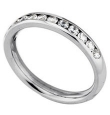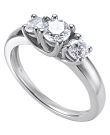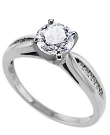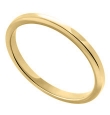14K White Gold 3 mm Tapered Comfort Fit Wedding Band with 12 Channel Set Diamonds (.36 ct. tw.)





Thank you to everyone at Danforth Diamond! My ring arrived today, and it's absolutely perfect. The only part I didn't like was having to wait for it to get here!
Best,
Liz
Diamonds are fascinating and by their very nature can be mesmerizing, especially if they are larger than your typical diamonds or have a history to them. These 5 famous diamonds have both "facets" and retain their place in diamond lore to this very day.
5. The Shah Diamond
The Shah diamond was discovered in India around 1450, and it has become a potent symbol of the royalty, war, and history of India from the sixteenth and seventeenth centuries. This diamond weighs 88.7 carats, and it is known for its crystalline clarity. The yellow diamond was seized, lost, and reclaimed by three different Shahs during ancient times, and it retains the inscriptions that they left there over time. One Shah, Jehan, chose a telling description of himself to be engraved upon the diamond: "ruler of the world". However, he would eventually lose the diamond as it was seized by another Shah. After the murder of a Russian member of the diplomatic corps in 1829, the reigning Shah offered the diamond to the Kremlin, as a way of pacifying them and ensuring no violent retribution towards him by the Soviet Union. In this manner, the ownership of the Shah diamond was lost to India forever.
4. The Hortensia Diamond
Our next famous diamond has a Napoleonic connection. It was named for Hortense, the daughter of the Empress Josephine. Hortense was also the step-daughter of Napoleon Bonaparte. The Hortensia is twenty carats in size, with a pale coral cast. This diamond disappeared, along with other French Crown Jewels, during the theft that took place in 1792. It was later recovered, along with the others, only to be stolen again in 1830. After the theft, the diamond was rapidly located and returned to its rightful owner. This diamond has a crack along its pavilion, unlike the other diamonds on our list. However, it is so steeped in French history and Napoleonic legend, that it retains its pricelessness despite the flaw. The stone now rests in the Louvre, a glittering symbol of France and of the courage of Napoleon, with whom it will always be linked.
3. The Eureka Diamond
This diamond was the first ever discovered in South Africa, one of the world’s most prolific sources of diamonds. The diamond was found by a young boy, while he worked as a shepherd, along the shores of Hopetown’s Orange River. This diamond weighed in at 231 carats before being faceted. The Eureka diamond eventually traveled to England for the inspection of Queen Victoria at Windsor Castle. This famous diamond, like many on our list, was destined to change owners many time, before being purchased by the diamond conglomerate, De Beers, in 1967; it is now on permanent display at the Kimberly Museum in South Africa, where it remains a symbol of one of South Africa’s most lucrative national resources.
2. The Dresden Green
This extraordinary and rare pear-shaped stone weighs in at 40.7- carats, and is named for the capital of Saxony: its unique, deep-green color sets it apart. The Dresden Green came from India, and it was sold to Frederick Augustus II, son of the ruler of Saxony, Frederick Augustus I. Known as Augustus the Strong, Frederick’s father commissioned the construction of many fine buildings in Dresden, and filled them with all manner of glorious art treasures he collected from around the world. Although Frederick Augustus I admired the diamond for years beforehand, Frederick Augustus II was the first to actually own it. The Dresden continued to be passed through royal ownership and admired for its flawless, emerald-green hue. It currently rests in the Albertinium Museum in Dresden: it was once displayed alongside the Hope Diamond at the Smithsonian Museum, at the request of noted jeweler Harry Winston, who felt that the Dresden was the only other stone in the world that could hold a candle to the Hope Diamond.
1. The Hope Diamond
No diamond remains more notorious and more renowned than the infamous Hope Diamond, which is surrounded by legend and history. Some believed that this huge, deep-blue diamond, which came from India, was cursed and would bring bad luck or even death to its wearer.
The first famous owner of the Hope Diamond was Louis XVI, the King of France. He bought the diamond from a French gem merchant, and its initial size was a staggering 112 3/16 carats. Louis chose to have the stone cut down to 67 1/8 carats, for use in the French Crown Jewels.
Its second owner was the next King of France, Louis XV, who reset the diamond in another royal jewelry piece, the Emblem of the Golden Fleece. During the French Revolution, the diamond was stolen during the looting and it did not surface again for 20 years. In 1812, the diamond reappeared in England under mysterious circumstances, and was snapped up by a wealthy collector, Philip Henry Hope. It remained in his family until it was sold again, and for years afterward, the Hope Diamond bounced back and forth between collectors.
Evelyn Walsh Mclean purchased the diamond in 1912: again, it was reduced and re-cut, this time to 45.52 carats, to suit Walsh’s taste. She relished tales of the Hope Diamond curse, even thought they were unfounded, as it pleased her to own such a notorious gem. She was rumored to keep the stone within the cushions of her sofa as a hiding place.
After her passing, the famed jeweler Harry Winston bought the Hope Diamond and donated it to the Smithsonian Museum, and, from its origins deep with the earth of India, over a billion years ago, it now belongs to the American people.
